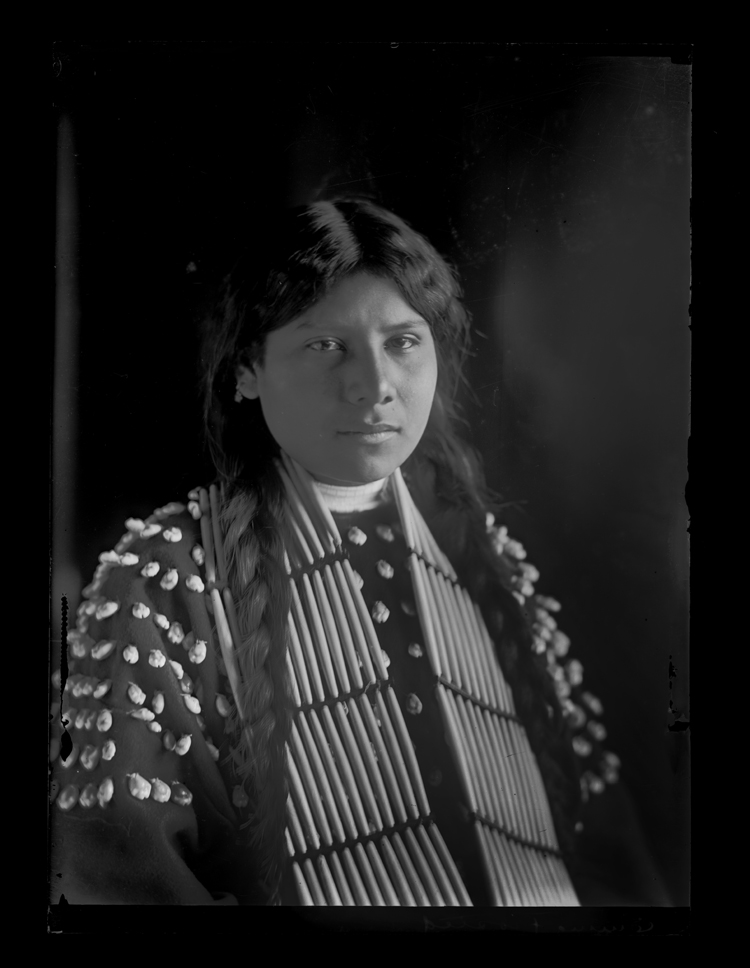Collection: 1952 - Frank Bennett Fiske
Item: 01898
Title: Emma Frosted
Date: 1910
Creator: Fiske, Frank Bennett,--1883-1952
Inscription/Marks: [in black ink at bottom of negative emulsion] Emma Frosted [negative envelope] Emma Frosted [Obituary for Tom Frosted Sioux County Pioneer-Arrow Fort Yates, (N.D.) Friday, Dec. 23, 1932 Vol. 22, No.11 ] Birth: 1859 Death: 20 Dec 1922 Old Chief Passes Away Early Tuesday Morning, Last of Hereditary Yanktoni Chieftains, White Bear or Thomas Frosted, Sought Happy Hunting Grounds After Active Government Service Life. The last of the hereditary Yanktoni Chieftains, Mato-ska, or White Bear, better known to white men as Thomas Frosted, passed away at his spacious log cabin on the banks of the meandering Porcupine creek, six miles north of Fort Yates. He sought out the Happy Hunting Grounds early Tuesday morning after a lingering illness which consumed the old Chieftains health to the very marrow. Frosted has lived a very interesting life in the land of the once powerful Sioux. Born and reared on the prairie among his people he led the life of a Sioux until early manhood at which time he became a friend of the whites and lived thereafter near the agency here. He served the "Grandfather" (Uncle Sam) in the role of Indian Policeman for more than two score years and at the time of his resignation was chief of that organization. White people must credit with due respect such a man who would join the white man and become a police official over his brothers who were for the most part at that time at war with the government. The deceased chieftain was born at Long Lake, Dakota Territory in 1859, making him 73 years of age at the time of his death; his father was known as Standing Bull and his mother, Singing. He vividly recalled on frequent occasions the well-known and much written about battle of Killdeer Mountains, in which General Sibley's troops participated. Frosted was then but a boy. As a boy in his late teens he attended Hampton Institute in Virginia where he learned the occupation of a carpenter and on his return here was for many years assistant carpenter at the agency. He built many structures, including school buildings and churches for the Indian People. In 1880, White Bear married a beautiful young Sioux woman, Orntopawin. The marriage took place in the Catholic Church with the Reverend Father Hug, officiating. The Frosted's were blessed with two children, but both have gone now to their rewards. The Frosted's took into their care seven other children. They are: John, August, Mary Brought Plenty, the latter deceased; Mary Standing Crow; and Asa, Susan and Francis Winters. In 1890, during the Sitting Bull trouble, Frosted was a scout for the military but took no active part in the actual arrest. In 1891 he began his career as an Indian policeman and served in this capacity until his resignation in 1915, at which time he had risen from the ranks and held the honored position as Chief of the Indian Police at the Standing Rock Reservation. In 1912 he held the distinction of being a special delegate to Washington to confer with authorities concerning Indian affairs. In 1914, when Sioux county was organized as a separate unit from old Morton county and given a full set of officials by appointment of the then Governor, L.B. Hanna, Frosted became one of the first constables. During the World War he was active in securing recruits among the Indian boys to serve the colors and sent his two adopted sons, August and John Brought Plenty, both of whom saw active service, the former with the 1st Division and the latter with the 33rd. Another patriotic gesture on the part of the chief which should be admired by the whites, for at that time the Indians were not considered citizens and had no duty to perform. White Bear, as chieftain, has presided at many notable ceremonies during which titles, Indian names, etc. have been conferred. Among the outstanding people who have received Indian names at Frosted's hands are: 1928-Ernest Thompson Seton, famous naturalist became Mahto-ska, and received a war bonnet. 1930-O.L. Bodenheimer, then National Commander of the American Legion, received a war bonnet and was named Flying Cloud. In 1930 the deceased chieftain presided at ceremonies which adopted a number of Bismarck folks into the Sioux tribe. Chief of Police Chris J. Martineson became Charging Eagle, his son Willard, Walking Warrior, D.E. Shipley, state official became Brown Eagle; Mrs. Alfred Zuger, chairman of Women's Federation of Labor, Red Deer; and Irene Engler, Red Bird. Funeral services were held Wednesday afternoon from the St. Peter's Catholic Church with Father Bernard, Frosted's old counselor and long-time friend, reading the last rites. Internment was made in the Catholic cemetery. Pall Bears were: D.S. Hatch, Benj. White, Ed Afraid of Hawks, Louis Endres, J.R. Harmon and Eli Swift Eagle. Honorary Pall Bears were: Frank Bennet Fiske, E.D. Mossman, Chris Martineson, F.B. Zahn and Victor Zahn. The Indians have lost a man who was considered one of their foremost leaders in all matters concerning their welfare. The whites have lost a true friend among the red men.
Burial:
Saint Peters Catholic Church Cemetery
Fort Yates
Sioux County
North Dakota, USA
Summary: Half-length, full face studio portrait of Emma Frosted in elk’s tooth dress with hairpipe breast plate. Her hair is pulled into two soft braids on either side of her face.
Red ID: PH_I_14297 Image ID: 145845 Image Notes: 1952-01898


